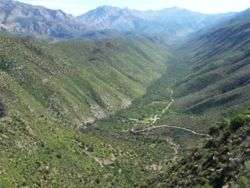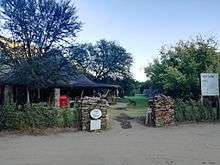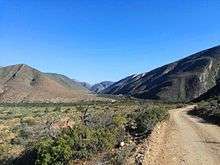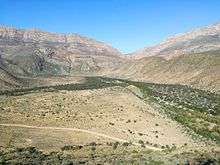Gamkaskloof
The Gamkaskloof Afrikaans pronunciation: [χamkaskluəf], also known as Die Hel, is a narrow, isolated valley about 20 kilometres (12.4 miles) long and a maximum of 600 metres (656 yards) wide. The valley is located in the Swartberg mountain range, which is part of the Garden Route District Municipality, Western Cape Province, South Africa.

History
Gamkaskloof is a hybrid name, combining Gamka (the Khoisan word for Lion), and Kloof (the Afrikaans word for valley).



The Gamkaskloof was discovered in the early 19th century by farmers, but the first permanent resident was Peter Swanepoel, who settled in the valley in the 1830s. Some time later, the Marais, Cordier and Joubert Nel Mostert families settled in the valley, growing to a community of around 160 people. The residents used donkeys and travelled by foot across the Swartberg mountains to reach Prince Albert and Calitzdorp. Later, a school was established, with the teacher also leading the Sunday church. The settlers farmed grain, vegetables, fruits, tea and tobacco. They also distilled witblits, and brewed beer from wild honey.
For many years, the residents petitioned the South African government to build a road into the valley. In 1962, the requested road was completed. Ironically, this led to the depopulation of the community, with the local children attending high schools in the nearby villages and most of them refusing to return to a life of subsistence farming in the valley. The elderly residents retired to retirement villages outside the valley, with the number of permanent residents diminishing. Eventually, all homes except one were sold to the Western Cape Nature Conservation Board, with the last sale taking place in 1991.
The Gamkaskloof valley was declared a national monument in 1997, and was subsequently included into the Swartberg Nature Reserve. The cottages in the valley have been renovated, and equipped with solar power and bathrooms.

Die Hel
The only formal road by which the Gamkaskloof can be accessed drops very steeply for almost 579 metres (547 yards) before reaching the valley settlement. It is believed that the name Die Hel was derived from the Afrikaans word helling or hel, meaning a steep dip or incline.[1] However, this is subject to debate and several folk toponyms and explanations have evolved. One popular story is that an animal inspector named Piet Botha visited the valley in the 1940s, using a particularly difficult route known as Die Leer, and subsequently described the experience as "hell". The residents of Gamkaskloof are averse to the name Die Hel, and refer to themselves as Klowers (the Afrikaans word for 'Canyon dwellers').
Activities


Gamkaskloof's isolation makes it popular among sports enthusiasts. Hiking is a popular activity. The valley also hosts a mountain bike race named To Hell & Back, and a trail run known as the MadScientists' Midnight Hell Run (formerly the Moonlight Hell Run). A number of adventure races have also used Gamkaskloof as part of their route.
References
| Wikimedia Commons has media related to Gamkaskloof. |
External links
- IOL Originally Published in the Cape Times 19 May 2003
- Website of the To Hell & Back MTB race
- MadScientists' Midnight Hell Run was cancelled in 2011